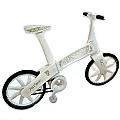How To Prototype

There are various types of modeling systems that can be used to create a prototype depending upon the objective you're trying to achieve.
The word prototype is a derived from the Greek words protos and typos, which means first and impression.
This article explains the reasons for creating prototypes.
Function
This type prototype is created to test the functionality of your design. It's not intended to determine appearance, materials or how your invention will be manufactured.
The purpose of this model is to validate motion and performance. In other words, to prove your invention does what you intend it to do. This type of prototype is used to isolate design flaws, identify improvement options, and to facilitate further testing and development.
Form
This type of prototype is created to study the size and form of your invention. It's not intended to determine function or performance.
The purpose of this model is to evaluate shape and dimensions. It is a non-working model. This prototype is usually hand-carved, sculpted, machined or otherwise made from such materials as foam, metal ,wood, paper or cardboard.
Appearance
This type of prototype is created to approximate the look and feel of your invention. It's not created to evaluate function. This prototype is useful for packaging mock-ups and as a model for photo or video shoots.
Computer
Computer modeling creates your invention as a computer prototype instead of a physical prototype. This technology creates design, form, appearance, material properties and function of your invention as a computer model.
This method of prototyping is used extensively in the aviation, automotive and software industry.
Electronic
This method is for prototyping circuits. A circuit can be constructed using various techniques to prove a design works. A printed circuit board can be made using inexpensive breadboard, stripboard or perfboard that are similar to printed circuit boards used for final production runs.
Final Model
This model combines earlier methods of prototyping and is a final model that incorporates the design, function, appearance and materials of your invention.
It can be scaled down to a smaller size to save costs and less expensive materials can be substituted for the final materials.
Alternatively, rapid prototyping technology is another method on how to prototype your invention. This process can create relatively inexpensive production-quality models.
3D Print Prototyping
 Parts can be created in three-dimensional printers. For example, bicycle parts are now designed and manufactured using this prototyping
method.
Parts can be created in three-dimensional printers. For example, bicycle parts are now designed and manufactured using this prototyping
method.
Bicycles are "grown" with nylon or metal powders using a three-dimensional layering and laser-sintering process.
The European Aerospace and Defence Group (EADS) was one of the first to demonstrate how bicycle's could be made this way.
The parts are structured, detailed and completely functional. Today, just about anything plastic or metal can be created in these machines - from fully functional musical instruments to fully operational bicycles. Watch the video below.
Source: eads.com Graphic Credit: Nemesis63




